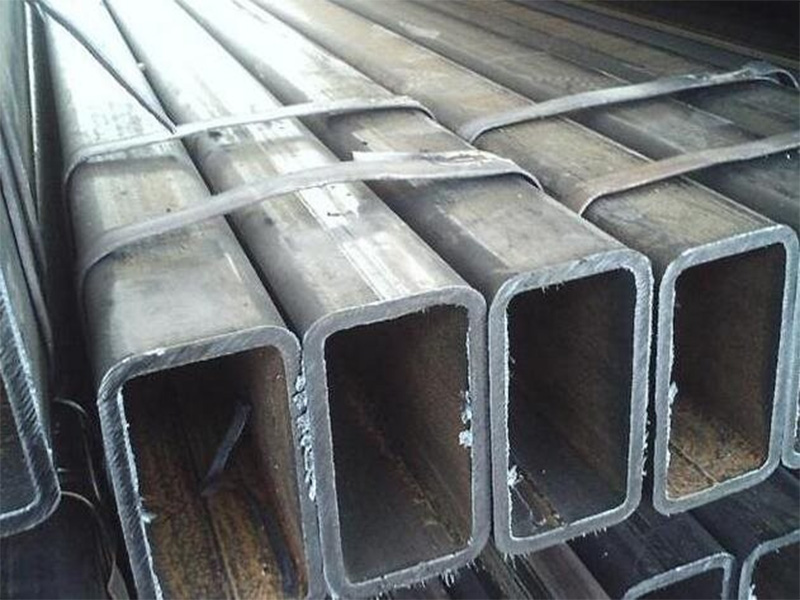

As the name suggests, it is a square-shaped tube, many kinds of materials can be formed into a square tube body, it media, what for, where, most of the square tube to the majority of steel tubes, after unpacking, flattening, curling, welding to form a round tube, and then from the round tube rolled into a square tube and then cut into the required length. Usually 50 square tubes per package are in stock with large specifications mostly in 10*10*0.8-1.5~~500*500*10-25, square tubes are divided into structural square tubes, decorative square tubes, construction square tubes, mechanical square tubes, etc. according to the usage.
Square tubes is a hollow square section light thin-walled steel pipe, also known as steel refrigeration bending profile. It is Q235 hot-rolled or cold-rolled strip or coil for the base material by cold bending process forming and then high-frequency welding made of square cross-sectional shape size of the section steel. Hot rolled extra thick wall square tube in addition to wall thickness thickening, its corner dimensions and edge straightness are up to or even exceed the level of resistance welding cold forming square tube.
Square tubes are used in construction, machinery manufacturing, steel construction projects, shipbuilding, solar power generation support, steel structure engineering, power engineering, power plants, agricultural and chemical machinery, glass curtain walls, automotive chassis, airports, boiler construction, highway railings, housing construction, etc.

1、Square tube production process classification
Square tube according to the production process: hot-rolled seamless square tube, cold-drawn seamless square tube, extruded seamless square tube, welded square tube.
Among them, welded square tube is divided into.
(a) according to the process – arc welding square tube, resistance welding square tube (high frequency, low frequency), gas welding square tube, furnace welding square tube
(b) according to the welding seam – straight seam welded square pipe, spiral welded square pipe
2、Square tube material classification
Square tube according to the material: plain carbon steel square tube, low alloy square tube. Plain carbon steel is divided into: Q195, Q215, Q235, SS400, 20# steel, 45# steel, etc.; low alloy steel is divided into Q345, 16Mn, Q390, ST52-3, etc.
3、Square pipe production standards classification
Square tube according to production standards: national standard square tube, Japanese standard square tube, British square tube, American standard square tube, European standard square tube, non-standard square tube.
4、Square tube cross-sectional shape classification
Square tube according to the shape of the section classification.
(1) simple section square tube – square square tube, rectangular square tube
(2) complex section square tube – flower-shaped square tube, open square tube, corrugated square tube, shaped square tube
5、Square tube surface treatment classification
Square tube according to the surface treatment: hot dip galvanized square tube, galvanized square tube, oiled square tube, pickled square tube
6、Square tube use classification
Square tube according to the classification of use – decorative square tube, machine tool equipment square tube, machinery industry square tube, chemical industry square tube, steel structure square tube, shipbuilding square tube, automotive square tube, steel beam column square tube, special purpose square tube
7、Wall thickness classification of square pipe
Square tube according to the wall thickness classification – super thick wall square tube, thick wall square tube and thin wall square tube
Plasticity
Plasticity is the ability of a metallic material to produce plastic deformation (permanent deformation) under load without damage.
Hardness
Hardness is a pointer to the degree of hardness or softness of a metallic material. The most commonly used method for determining hardness in production is the indentation hardness method, which uses an indenter of a certain geometry to press into the surface of the tested metal material under a certain load and determines its hardness value according to the degree of being pressed into it.
Commonly used methods are Brinell hardness (HB), Rockwell hardness (HRA, HRB, HRC) and Vickers hardness (HV) methods.
Fatigue
The strength, plasticity and hardness discussed earlier are all pointers to the mechanical properties of the metal under static load. In fact, many machine parts work under cyclic loads, and under such conditions the parts produce fatigue.
Impact toughness
The load acting on the machine part at a large speed is called impact load, and the ability of the metal to resist damage under impact load is called impact toughness.
Strength is the performance of a metal material to resist damage (excessive plastic deformation or fracture) under a static load. As the load is in the form of tensile, compression, bending, shear, etc., so the strength is also divided into tensile strength, compressive strength, bending strength, shear strength, etc.. There is often a certain connection between the various strengths, the use of the general tensile strength as the most basic strength pointer.
1. GB6728-2002 cold-formed hollow section steel standard for structural use can be implemented.
2. JISG3466-88 Japanese standard for general structural rectangular tube adaptation range can be implemented
Square tube meter weight calculation formula: side length * 4 * wall thickness * 0.00785
Rectangular tube meter weight calculation formula: (side length + side length) * 2 * wall thickness * 0.00785

For Further Details,Please Feel Free To Contact Us: